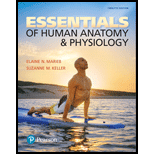
Essentials of Human Anatomy & Physiology (12th Edition)
12th Edition
ISBN: 9780134395326
Author: Elaine N. Marieb, Suzanne M. Keller
Publisher: PEARSON
expand_more
expand_more
format_list_bulleted
Concept explainers
Question
Chapter 6, Problem 14SAE
Summary Introduction
To review:
To define the neurotransmitter, neuromuscular junction, graded response motor unit, anaerobic glycolysis, tetanus, aerobic respiration, and muscle fatigue.
Introduction:
These terms are related to the activity of the skeletal muscles in the body.
Expert Solution & Answer
Want to see the full answer?
Check out a sample textbook solution
Students have asked these similar questions
State the five functions of Globular Proteins, and give an example of a protein for each function.
Diagram of check cell under low power and high power
a couple in which the father has the a blood type and the mother has the o blood type produce an offspring with the o blood type, how does this happen? how could two functionally O parents produce an offspring that has the a blood type?
Chapter 6 Solutions
Essentials of Human Anatomy & Physiology (12th Edition)
Ch. 6 - If you compare electron micrographs of a relaxed...Ch. 6 - After ACh attaches to its receptors at the...Ch. 6 - Your ability to lift that heavy couch would be...Ch. 6 - 4. Doing the pincer grasp is an ___________...Ch. 6 - 5. Which are ways in which muscle names have...Ch. 6 - 6. Which of the following muscles attach to the...Ch. 6 - Which of these thigh muscles causes movement at...Ch. 6 - 8. Which of the following insert on the...Ch. 6 - What is major function of muscle?Ch. 6 - Compare skeletal, smooth, and cardiac muscles in...
Ch. 6 - What two types of muscle tissue are striated?Ch. 6 - 12. Why are the connective tissue wrappings of...Ch. 6 - Prob. 13SAECh. 6 - Prob. 14SAECh. 6 - Prob. 15SAECh. 6 - Prob. 16SAECh. 6 - Prob. 17SAECh. 6 - Prob. 18SAECh. 6 - 19. List the 12 body movements studied in this...Ch. 6 - Prob. 20SAECh. 6 - If you were alternately contracting and relaxing...Ch. 6 - The sternocleidomastoid muscles help to flex the...Ch. 6 - Prob. 23SAECh. 6 - Name the prime mover of elbow flexion. Name its...Ch. 6 - Prob. 25SAECh. 6 - The hamstring and quadriceps muscle groups are...Ch. 6 - 27. What two-bellied muscle makes up the calf...Ch. 6 - 28. What happens to muscles when they are...Ch. 6 - Prob. 29SAECh. 6 - 30. Should a triathlete engage in aerobic or...Ch. 6 - Prob. 31SAECh. 6 - Prob. 32SAECh. 6 - Prob. 33CTCh. 6 - Prob. 34CTCh. 6 - Prob. 35CTCh. 6 - 36. When Eric returned from jogging, he was...Ch. 6 - 37. Chemical A binds and blocks acetylcholine...Ch. 6 - Kendra’s broken leg was in a cast for 8 weeks....
Knowledge Booster
Learn more about
Need a deep-dive on the concept behind this application? Look no further. Learn more about this topic, biology and related others by exploring similar questions and additional content below.Similar questions
- What is the opening indicated by the pointer? (leaf x.s.) stomate guard cell lenticel intercellular space none of thesearrow_forwardIdentify the indicated tissue? (stem x.s.) parenchyma collenchyma sclerenchyma ○ xylem ○ phloem none of thesearrow_forwardWhere did this structure originate from? (Salix branch root) epidermis cortex endodermis pericycle vascular cylinderarrow_forward
- Identify the indicated tissue. (Tilia stem x.s.) parenchyma collenchyma sclerenchyma xylem phloem none of thesearrow_forwardIdentify the indicated structure. (Cucurbita stem l.s.) pit lenticel stomate tendril none of thesearrow_forwardIdentify the specific cell? (Zebrina leaf peel) vessel element sieve element companion cell tracheid guard cell subsidiary cell none of thesearrow_forward
- What type of cells flank the opening on either side? (leaf x.s.) vessel elements sieve elements companion cells tracheids guard cells none of thesearrow_forwardWhat specific cell is indicated. (Cucurbita stem I.s.) vessel element sieve element O companion cell tracheid guard cell none of thesearrow_forwardWhat specific cell is indicated? (Aristolochia stem x.s.) vessel element sieve element ○ companion cell O O O O O tracheid O guard cell none of thesearrow_forward
- Identify the tissue. parenchyma collenchyma sclerenchyma ○ xylem O phloem O none of thesearrow_forwardPlease answer q3arrow_forwardRespond to the following in a minimum of 175 words: How might CRISPR-Cas 9 be used in research or, eventually, therapeutically in patients? What are some potential ethical issues associated with using this technology? Do the advantages of using this technology outweigh the disadvantages (or vice versa)? Explain your position.arrow_forward
arrow_back_ios
SEE MORE QUESTIONS
arrow_forward_ios
Recommended textbooks for you
 Human Physiology: From Cells to Systems (MindTap ...BiologyISBN:9781285866932Author:Lauralee SherwoodPublisher:Cengage Learning
Human Physiology: From Cells to Systems (MindTap ...BiologyISBN:9781285866932Author:Lauralee SherwoodPublisher:Cengage Learning Human Biology (MindTap Course List)BiologyISBN:9781305112100Author:Cecie Starr, Beverly McMillanPublisher:Cengage LearningLifetime Physical Fitness & WellnessHealth & NutritionISBN:9781337677509Author:HOEGERPublisher:Cengage
Human Biology (MindTap Course List)BiologyISBN:9781305112100Author:Cecie Starr, Beverly McMillanPublisher:Cengage LearningLifetime Physical Fitness & WellnessHealth & NutritionISBN:9781337677509Author:HOEGERPublisher:Cengage

Human Physiology: From Cells to Systems (MindTap ...
Biology
ISBN:9781285866932
Author:Lauralee Sherwood
Publisher:Cengage Learning

Human Biology (MindTap Course List)
Biology
ISBN:9781305112100
Author:Cecie Starr, Beverly McMillan
Publisher:Cengage Learning

Lifetime Physical Fitness & Wellness
Health & Nutrition
ISBN:9781337677509
Author:HOEGER
Publisher:Cengage



GCSE PE - ANTAGONISTIC MUSCLE ACTION - Anatomy and Physiology (Skeletal and Muscular System - 1.5); Author: igpe_complete;https://www.youtube.com/watch?v=6hm_9jQRoO4;License: Standard Youtube License